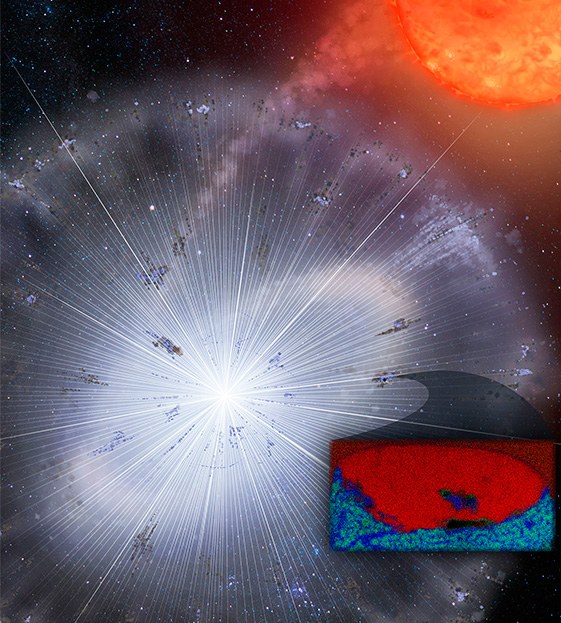The analysis of a meteorite reveals secrets about the birth of the solar system
May 30, 2019
An international team of cosmochemists and astrophysicists, which includes Jordi José, a researcher from the Physics Department of the UPC and the Institut d'Estudis Espacials de Catalunya (IEEC), has discovered a meteorite grain forged during the final phases of a star disappeared a long time ago. Encapsulated in a meteorite collected in Antarctica, the tiny grain - only a few microns in size - has shed new light on the terminal phases of star life and how they sow the universe with the building blocks of new stars, planets and life.
Nicknamed LAP-149, the small grain was confined in a rocky, non-metallic meteorite found in Antarctica and represents the first meteorite grain found to be composed at the same time by graphite and silicate. Its origin can be traced back to a specific type of stellar explosion called nova. Surprisingly, as stated by Jordi José, who besides being a researcher at the Physics Department of the Universitat Politècnica de Catalunya · BarcelonaTech (UPC) and the Institute of Space Studies of Catalonia (IEEC) is a professor of physics at the School of Engineering of Barcelona East (EEBE), "the grain was incorporated and mixed with the nebular material that, shortly after, would give place to the Solar System, about 4,500 million years ago, to later be embedded in a primitive meteorite". The discovery challenges some of the current ideas about how dying stars sow the universe with raw materials, from which planets will form and, ultimately, become the precursor molecules of life.
As explained by Pierre Haenecour, researcher at the University of Arizona, who has led the research published in the journal Nature Astronomy, "like the real dust of the stars, said grains from the presolar era They give an idea of the building blocks from which our solar system was formed. They also provide a direct snapshot of the conditions of the star at the time this grain was formed "
Novas are binary stellar systems composed of a compact star, called white dwarf, and a little massive companion, of the main sequence or red giant. The white dwarf sucks material from the companion star. Once it accumulates enough star material, the white dwarf burns again in periodic bursts violent enough to forge new chemical elements and throw them into space. In these and other stellar explosions, the elements that constitute the basis of life on Earth are created. Jordi José assures us that "stellar explosions make it possible to understand how the universe, which during the first hundreds of millions of years after the Big Bang was chemically very poor, with the only presence of hydrogen, helium and a little lithium, has been progressively enriched with most of the chemical species found in the periodic table today. They are the foundation of our planet and our bodies. "
The team of researchers at the University of Arizona has analyzed the small messenger from outer space, about the size of a microbe, to the atomic level. LAP-149 has been analyzed with a multitude of first level experimental techniques and has proved to be really strange: when studied with a technique called secondary ion mass spectrometry, which allows to distinguish between different varieties of atoms called isotopes, LPA-149 resulted highly enriched in the 13C carbon isotope. The carbon isotopic composition (that is, the quotient 12C / 13C) measured on any planet or object in our solar system typically varies by a factor of the order of 5. However, the 13C found in LAP-149 is enriched by more than 50,000 times. LAP-149 shows that the novae have polluted the gas from which the solar system was formed with grains rich in carbon and oxygen.
Although their progenitor stars no longer exist, the isotopic composition and microstructure of the dust grains of star origin identified in meteorites provide unique data on their formation and on the thermodynamic conditions in the material ejected by the stars, according to the authors. The detailed analysis of LAP-149 revealed even more unexpected secrets: unlike other similar grains extracted from meteorites forged in dying stars, this is the first known grain containing graphite (the material from which a pencil's mine is made) and a central inclusion rich in silicates.
"Our finding provides a vision of a process we could never witness on Earth," adds Haenecour. "It tells us how meteorite grains form in the material expelled by a nova. We now know that grains rich in carbon and oxygen can be formed simultaneously in the same material ejected by a nova, possibly in regions of different chemical composition, something that had already been predicted by simulations of nova explosions but that had never been observed before in the laboratory".
According to Jordi José, LAP-149 has unveiled a lot of information about the condensation processes in the material ejected by the novae and their contribution to the chemical composition of the solar system. "LAP-149 has had a truly haphazard life: it was created in space, from material ejected in a stellar explosion; it wandered through the interstellar medium, surviving cosmic rays and high-energy radiation, until it was trapped in the cloud of gas and dust that would become our solar system, "adds the researcher at the UPC. Thus, the meteoric grain wandered for an unknown time in the primitive solar system, before becoming part of an asteroid that later fell to Earth and from which it was extracted by scientists at the University of Arizona.
Laboratory evidence for co-condensed oxygen- and carbon-rich meteoritic stardust from nova outbursts.
P. Haenecour, J. Y. Howe, T. J. Zega, S. Amari, K. Lodders, J. José, K. Kaji, T. Sunaoshi, A. Muto.
Nature Astronomy (2019)
DOI: 10.1038/s41550-019-0757-4

Share: